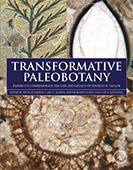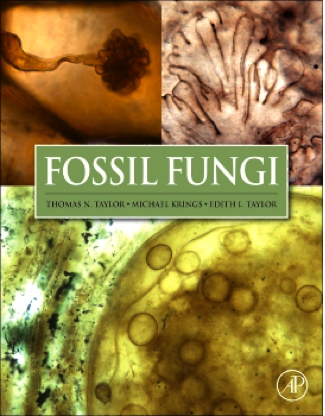Publications Prof. Dr. Michael Krings

Papers to Commemorate the Life and Legacy of Thomas N. Taylor,
London, San Diego, CA, Cambridge, MA, Oxford, Elsevier/Academic Press Inc., xxvi + 705 p.


The Biology and Evolution of Fossil Plants. Burlington MA, London, San Diego CA, New York NY, Elsevier/Academic Press Inc., xxi + 1230 pp.
Recent scientific papers
In press
- Luo C, Haelewaters D, Krings M: Fossils of parasitic fungi. – In: Haelewaters D (ed.), Biodiversity and Evolution of Fungal Parasites and Pathogens. Elsevier.
2025
- Krings, M.: Unusual chytrid-like fossils in a land plant cell from the Rhynie cherts. – Review of Palaeobotany and Palynology 337, 105315.
- Moore, Z., Krings, M.: Morphological diversity of fungal reproductive units in the Lower Devonian Rhynie cherts of Scotland: A new type with a two-layered hyphal mantle. – Neues Jahrbuch für Geologie und Paläontologie, Abhandlungen 313, 233–243.
2024
- Garcia Cabrera N, Krings M: Fungi colonizing bulbils of the charophyte green alga Palaeonitella cranii from the Lower Devonian Rhynie chert, Scotland. – Neues Jahrbuch für Geologie und Paläontologie, Abhandlungen 310, 99–117.
- Hiller P, Krings M, Kerp H, Zhuo F, Bomfleur B: Evidence of profuse bark shedding in Dicroidium seed ferns (Umkomasiales) from the Triassic of Antarctica. – Polar Research 43, 10657.
- Kiel S, Goedert JL, Huynh TL, Krings M, Parkinson D, Romero R, Looy CV: Early Oligocene kelp holdfasts and stepwise evolution of the kelp ecosystem in the North Pacific. – Proceedings of the National Academy of Sciences of the United States of America 121, e2317054121.
- Krings M: Algae from the Lower Devonian Rhynie chert: Harpericystis verecunda gen. et sp. nov., a probable green alga (Chlorophyta) that forms few-celled colonies. – Review of Palaeobotany and Palynology 331, ID105190.
- Krings M: Deciphering interfungal relationships in the 410-million-yr-old Rhynie chert: A chytrid-like colonizer of glomeromycotan hyphae. – Nova Hedwigia 118, 115–132.
- Krings M: Further observations on stalked microfossils from the Lower Devonian Rhynie cherts that resemble the algae Characiopsis (Eustigmatophyceae) and Characium (Chlorophyceae). – Review of Palaeobotany and Palynology 324, ID105081.
- Krings, M.: Deciphering interfungal relationships in the 410-million-yr-old Rhynie chert: Rhizophydites shutei sp. nov. (fossil Chytridiomycota) on glomeromycotan acaulospores – Fossil Imprint80, 77–89.
- Krings, M.: Rhizophydites bicornis nov. sp. (fossil Chytridiomycota) from the Rhynie chert, Scotland. – Folia Musei Rerum Naturalium Bohemiae Occidentalis. Geologica et Paleobiologica 58, 1–7.
- Liu F, Hiller P, Krings M, Bomfleur B, Wang X, Cheng Y: Fossil Xenoxylon (Coniferopsida) wood from the Upper Cretaceous of Heilongjiang, China: evidence of a tripartite plant-arthropod-fungal association. – Cretaceous Research 157, ID105822.
- Sanchez-Posada, C., Racicot, R.A., Ruf, I., Krings, M., Rössner, G.E.: Romaleodelphis pollerspoecki, gen. et sp. nov., an archaic dolphin from the Central Paratethys (Early Miocene, Austria). – Journal of Vertebrate Paleontology 44, e2401503.
2023
- McMahon S, Loron CC, Cooper LM, Hetherington AJ, Krings M (2023): Entophysalis in the Rhynie chert (Lower Devonian, Scotland): implications for cyanobacterial evolution. – Geological Magazine 160, 1946–1952.
- Decombeix AL, Harper CJ, Prestianni C, Durieux T, Ramel M, Krings M: Fossil evidence of tylosis formation in Late Devonian plants. – Nature Plants 9, 695–698.
- Hellwig A, Trümper S, Rößler R, Krings M: Freshwater stromatolites from an early Permian wetland (Manebach, Thuringian-Forest Basin, Germany): Structure, development, and paleoenvironmental context. – Palaios 38, 353–370.
- Krings M, Garcia Cabrera N: The bulbils of Palaeonitella cranii (Charales, Charophyceae) revisited, with notes on other inflated cells of this alga that are not bulbils. – Review of Palaeobotany and Palynology 318, ID104987.
- Krings M, Harper CJ: A fungal mycelium containing abundant endoconidia from the Lower Devonian Rhynie cherts of Scotland. – Review of Palaeobotany and Palynology 313, ID104891.
- Krings M, Harper CJ, Decombeix AL, Galtier J: The core of Sporocarpon asteroides, an enigmatic fungal fossil from the Carboniferous. – Neues Jahrbuch für Geologie und Paläontologie, Abhandlungen 309, 111–122.
- Kustatscher E, Roghi G, Reich M, Röper M, Krings M: The Late Jurassic Plattenkalk flora of Bavaria, Germany: What about palynology? – Neues Jahrbuch für Geologie und Paläontologie, Abhandlungen 310, 51–70.
2021
- García Massini, J.L., Guido, D.M., Campbell, K.C., Sagasti, A.J., Krings, M.: Filamentous cyanobacteria and associated microorganisms, structurally preserved in a Late Jurassic chert from Patagonia, Argentina. – Journal of South American Earth Sciences 107, no. 103111.
- Halbwachs, H., Harper, C.J., Krings M.: Fossil Ascomycota and Basidiomycota, with notes on fossil lichens and nematophytes. In: O. Zaragoza, A. Casadevall (Eds.), Encyclopedia of Mycology, vol 1, pp. 378–395, Amsterdam, Elsevier Sciences Ltd.
- Harper, C.J., Krings, M.: Fungi as parasites: a conspectus of the fossil record. – In: K. de Beats, J.W. Huntley (Eds.), The Evolution and Fossil Record of Parasitism – Identification and Macroevolution of Parasites (Topics in Geobiology, vol. 49), pp. 69–108, Cham, Springer.
- Krings, M.: Peculiar bundles and a knot of thin filaments in microbial mats from the Lower Devonian Rhynie and Windyfield cherts. – Review of Palaeobotany and Palynology 291, no. 104442.
- Krings, M.: Rhyniotaxillus minutulus n. sp., a pico-sized colonial cyanobacterium from the 410-million-yr-old Windyfield chert of Scotland. – Nova Hedwigia 113, 17–31.
- Krings, M.: The Rhynie chert land plant Aglaophyton majus harbored cyanobacteria in necrotic local lesions. – Neues Jahrbuch für Geologie und Paläontologie, Abhandlungen 300, 279–289.
- Krings, M.: Stigonema (Nostocales, Cyanobacteria) in the Rhynie chert (Lower Devonian, Scotland). – Review of Palaeobotany and Palynology 295, no. 104505.
- Krings, M.: Triskelia scotlandica, an enigmatic Rhynie chert microfossil revisited. – PalZ 95, 1–15.
- Krings, M., Serbet, S.M., Harper, C.J.: Rhizophydites matryoshkae gen. et sp. nov. (fossil Chytridiomycota) on spores of the early land plant Horneophyton lignieri from the Lower Devonian Rhynie chert. – International Journal of Plant Sciences 182, 109–122.
- Moisan, P., Krings, M., Voigt, S., Kerp, H.: Fossil roots with root nodules from the Madygen Formation (Ladinian–Carnian; Triassic) of Kyrgyzstan. – Geobios 64, 65–75.
- Walker, C., Harper, C.J., Brundrett, M., Krings, M.: The Early Devonian fungus Mycokidstonia sphaerialoides from the Rhynie chert is a member of the Ambisporaceae (Glomeromycota, Archaeosporales), not an ascomycete. – Review of Palaeobotany and Palynology 287, no. 104384.
2020
- Butzmann, R., Göhlich, U.B., Bassler, B., Krings, M.: Macroflora and charophyte gyrogonites from the middle Miocene Gračanica deposits in central Bosnia and Herzegovina. – Palaeobiodiversity and Palaeoenvironments 100, 479–491.
- Harper, C.J., Taylor, E.L., Krings, M.: Filamentous cyanobacteria preserved in masses of fungal hyphae from the Triassic of Antarctica. – PeerJ 8, e8660.
- Harper, C.J., Walker, C., Schwendemann, A., Kerp, H., Krings, M.: Archaeosporites rhyniensis gen. et sp. nov. (Glomeromycota, Archaeosporaceae), from the Lower Devonian Rhynie chert – a fungal lineage morphologically unchanged for more than 400 million years. – Annals of Botany 126, 915–928.
- Krings, M., Harper, C.J.: Deciphering interfungal relationships in the 410-million-yr-old Rhynie chert: Brijax amictus gen. et sp. nov. (Chytridiomycota) colonizing the walls of glomeromycotan acaulospores. – Review of Palaeobotany and Palynology 281, no. 104287.
- Krings, M., Harper, C.J.: Morphological diversity of fungal reproductive units in the Lower Devonian Rhynie and Windyfield cherts, Scotland: A new species of the genus Windipila. – PalZ Paläontologische Zeitschrift 94, 619–632.
- Schmidt, A.R., Regalado, L., Westrand, S., Korall, P., Sadowski, E.M., Schneider, H., Jansen, E., Bechteler, J., Krings, M., Müller, P., Wang, B., Wang, X., Rikkinen, J., Seyfullah, L.J.: Selaginella was hyperdiverse already in the Cretaceous. – New Phytologist 228, 1176–1182.
2019
- Harper, C.J., Galtier, J., Taylor, T.N., Taylor, E.L., Rößler, R., Krings, M.: Distribution of fungi in a Triassic fern stem. – Earth and Environmental Science Transactions of the Royal Society of Edinburgh 108, 387–398.
- Harper, C.J., Krings, M.: Nimbosphaera rothwellii nov. gen. et sp., an enigmatic microfossil enveloped in a prominent sheath from the Lower Devonian Windyfield chert, Scotland. – International Journal of Plant Sciences 180, 558–570.
- Krings, M.: Palaeolyngbya kerpii nov. sp., a large filamentous cyanobacterium with affinities to Oscillatoriaceae from the Lower Devonian Rhynie chert. – PalZ 93, 377–386.
- Krings, M., Harper, C.J.: A microfossil resembling Merismopedia (Cyanobacteria) from the 410-million-yr-old Rhynie and Windyfield cherts – Rhyniococcus uniformis revisited. – Nova Hedwigia 108, 17–35.
- Krings, M., Harper, C.J.: A new species of Perexiflasca, enigmatic microfossils with suggested affinities to Chytridiomycota (Fungi) from the Lower Devonian Rhynie and Windyfield cherts. – Geobios 56, 107–114.
- Krings, M., Harper, C.J.: Fungal intruders of enigmatic propagule clusters occurring in microbial mats from the Lower Devonian Rhynie chert. – PalZ 93, 135–149.
- Krings, M., Kerp, H.: A tiny parasite of unicellular microorganisms from the Lower Devonian Rhynie and Windyfield cherts, Scotland. – Review of Palaeobotany and Palynology 271, article no. 104106.
- Krings, M., Sergeev, V.N.: A coccoid, colony-forming cyanobacterium from the Lower Devonian Rhynie chert that resembles Eucapsis (Synechococcales) and Entophysalis (Chroococcales). – Review of Palaeobotany and Palynology 268, 65–71.
- Regalado, L., Schmidt, A.R., Müller, P., Niedermeier, L., Krings, M., Schneider, H.: Heinrichsia cheilanthoides gen. et sp. nov., a fossil fern in the family Pteridaceae (Polypodiales) from the Cretaceous amber forests of Myanmar. – Journal of Systematics and Evolution 57, 329–338.

